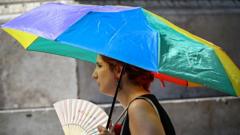Despite the oppressive heat, the All England Lawn Tennis and Croquet Club took strong measures to address safety concerns on the hottest opening day in Wimbledon’s history. With organizers projecting soaring temperatures, special protocols were established well ahead of the matches, totaling over 100 water refill stations throughout the grounds and the distribution of 6,700 refillable water bottles to staff.
The oppressive heat, with temperatures exceeding 90°F (32°C), raised concerns for players and fans alike. Shade areas were created following detailed shade mapping to help attendees seek relief from the relentless sun. Organizers assured the public that they had comprehensive plans in place to combat the scorching conditions as matches commenced.
During these intensifying conditions, Spanish defending champion Carlos Alcaraz became aware of a concerning situation. A fan in the stands collapsed, prompting him to alert officials and assist by sharing a cold water bottle. This prompted a brief interruption in the match as medical personnel addressed the incident. Such occurrences underline the necessity of vigilance in extreme weather and the importance of hydration.
In showcasing their adaptability in the face of climate challenges, Wimbledon serves as a case study for sports events navigating rising global temperatures, emphasizing the significance of proactive measures in ensuring safety and enjoyment for all participants. As climate change continues to impact outdoor activities globally, events like Wimbledon highlight the urgent need for sustainable practices and innovations in sports management.
The oppressive heat, with temperatures exceeding 90°F (32°C), raised concerns for players and fans alike. Shade areas were created following detailed shade mapping to help attendees seek relief from the relentless sun. Organizers assured the public that they had comprehensive plans in place to combat the scorching conditions as matches commenced.
During these intensifying conditions, Spanish defending champion Carlos Alcaraz became aware of a concerning situation. A fan in the stands collapsed, prompting him to alert officials and assist by sharing a cold water bottle. This prompted a brief interruption in the match as medical personnel addressed the incident. Such occurrences underline the necessity of vigilance in extreme weather and the importance of hydration.
In showcasing their adaptability in the face of climate challenges, Wimbledon serves as a case study for sports events navigating rising global temperatures, emphasizing the significance of proactive measures in ensuring safety and enjoyment for all participants. As climate change continues to impact outdoor activities globally, events like Wimbledon highlight the urgent need for sustainable practices and innovations in sports management.























